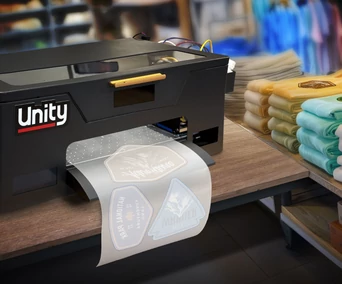As more and more people embrace the versatility of DTF and use this technology to their business this one question usually follows: ”How do I keep my DTF printer in good condition? Is it hard to do the cleaning and maintenance? Do I really have to print every day to prevent the printhead from clogging?”
Whether you’re using a desktop size, a compact or an industrial setup, proper maintenance is essential - and very similar in each case. Doing the regular cleaning is like an oil change for a car, the quality of the prints and the lifetime of the printer depend heavily on it.
In this blog post we’ll break down the key routines and we’ll share some tips and tricks that will help you extend the life of your printer, which will prevent frustrating downtime and keep your results fine.
Daily maintenance – your first line of defense
It may sound tedious, but the truth is it only takes a few minutes and later it can save you hours of troubleshooting. So lets see the key steps:
Agitate the white ink
The DTF ink is a water-based pigment ink which tends to settle at the bottom of the cartridge, especially the white ink. If the pigments settle on the bottom for too long it can cause pigment separation, that can lead to clogging and very poor print quality.
Extra tip: Before opening a new bottle ink shake that also, so the ink will be ready to use.
Run a nozzle check before every job
We know that it can sound frustrating and useless, but it’s not. It only takes a minute and will give you an immediate alert if something is wrong with the nozzles. If the test print doesn’t seem perfect just run a light head clean cycle and recheck. This step is crucial if you don’t want to risk to print a whole job and only realize the issue afterward.
Wipe down the printhead area
Use a lint-free cloth or a cleaning stick and proper cleaning solution for this step, gently wipe around the printhead are to remove any stray ink or dust. With this you can help to reduce the risk of smudges, ink drips or dried buildup that could result in bigger issues later on.
Extra tip: Check the capping station and the wiper, these are the parts that are often overlooked but critical for keeping the head clean and to proivding the necessary moisture when its not in use.
Weekly and monthly maintenance – a deeper dive
Beyond daily routines, your printer needs a deep and more thorough clen on longer time periods, depending on your printing volume.
Printhead
If you notice streaky prints or repeated nozzle dropouts then you should do a deep clean for the printhead. We suggest to dip it in the special cleaning solution for DTF. It is strictly forbidden to use water or any household cleaner or anything else - these can permanently damage your machine.
Dampers and filters
As dampers are responsible to help regulate ink flow and protect the printhead from pressure spikes or air bubles over time these can wear out, especially if your inks have been sitting unused. We recommend to check these monthly and change accordingly.
Moving parts – belts, rollers, rail
Since belts and rollers play key roles in the pringint process you should always keep an eye on these too. On these parts dust can sit, it can be worn which can cause uneven movement. Firstly apply a small amount of lubricant if needed especially n metal rails and make sure no lint or fabric particles are interfering with smooth operation.
Conclusion – A little care goes a long way
DTF printing is a powerful and efficient way to create unique designs and products but only if your machine is in a good condition. Whether you’re printing a dozen custom t-shits a day or hundreds of transfers for your resellers, an appropriate maintenance routine will ensure that your prints stay sharp and high-quality.
If you need help with maintenance or have a specific question please feel free to contact us and our technician colleagues will be happy to help you out.
In the next posts we will bring some common DTF print issues and quick troubleshooting for them.
If you’re still hesitating that DTF is the way to go for your business we recommend the previous blogs to read:

